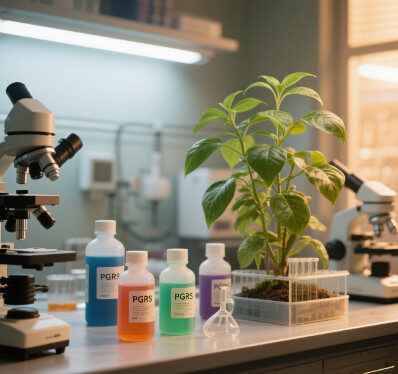Introduction
As global agriculture faces unprecedented challenges, such as climate change, population growth, and resource scarcity, sustainable intensification has become imperative. Plant growth regulators (PGRs), which are synthetic or natural compounds that modulate plant hormonal processes, are a powerful tool for enhancing crop productivity, stress resilience, and quality. This article provides an overview of PGR classification, mechanisms, agricultural applications, market trends, safety considerations, and future perspectives, offering insights for international stakeholders in the agricultural inputs sector.
Classification and Mechanisms of PGRs
To better understand the role of plant growth regulators (PGRs) in agriculture, it is essential to explore their classification and mechanisms of action. PGRs are classified based on their physiological functions. Key classes include:
- Growth Promoters, which include auxins, gibberellins, and cytokinins. These growth promoters enhance vegetative growth and reproductive transitions, improving fruit set by 15-40% and stimulating cell division.
- Growth retardants (e.g., chlormequat and paclobutrazol), which control shoot elongation by 30-50% and boost flower bud differentiation and postharvest quality.
- Growth inhibitors (e.g., maleic hydrazide) suppress terminal growth and accelerate maturity synchronization.
- Preservation agents (e.g., 1-MCP) extend shelf life by delaying senescence processes and reducing respiration rates by 20%-35%.
- Anti-transpirants (e.g., fulvic acids) mitigate water stress by reducing stomatal conductance by 40%-60% and enhancing root water uptake efficiency.
These compounds act through diverse mechanisms:
- Auxins activate proton pumps for cell wall loosening.
- Gibberellins degrade DELLA proteins to promote elongation.
- Cytokinins trigger cell division signaling.
- ABA regulates stomata via phosphorylation cascades. They are effective at ultralow concentrations (0.01-10 ppm) and precisely modulate endogenous hormone balances.
Agricultural Applications: Precision and Impact
- Plant growth regulators (PGRs) are strategically applied across crop systems.
- Auxins (e.g., NAA) stimulate rooting in cuttings at concentrations of 500–2,000 ppm and induce fruit thinning in apples at 5–20 ppm.
- Gibberellins (GA3) elongate grape bunches at concentrations of 5-20 ppm and induce parthenocarpy in fruits. They are also used in barley malt production at concentrations of 1-2 ppm.
- Cytokinins (6-BA) delay senescence in leafy vegetables (10–20 ppm) and increase kiwifruit size (5–10 ppm), improving marketable yield by 20–30%.
- ABA preconditions crops for drought stress (100–200 μM) and induces dormancy in nursery stocks.
The global PGR market was valued at $3.2 billion in 2023 and is projected to grow at a compound annual growth rate (CAGR) of 8.7% through 2030. This growth is driven primarily by increasing demand for high-value crops, such as fruits, vegetables, and flowers, and by the adoption of sustainable agricultural practices in regions like North America and Europe. Modern agriculture employs over 40 active PGR ingredients, optimizing growth stages from germination to postharvest.
Emerging Trends: Innovation and Sustainability
- Nano-Encapsulation: Nanoparticles can improve the stability of plant growth regulators (PGRs) by 30-50% and enable targeted delivery, thereby reducing environmental exposure.
- Precision Application: Drone-based variable-rate spraying with a coefficient of variation of less than 15% and smart hydrogel systems minimize overuse.
- Green Chemistry: Bio-based plant growth regulators (PGRs) from microbial fermentation align with circular economy principles.
- AI Integration: Machine learning models predict stage-specific growth recipes, enhancing efficiency by 15-25%.
- System integration: Combining plant growth regulators (PGRs) with biostimulants and biocontrols increases crop resilience and reduces chemical inputs by 20-35%.
Safety and Regulatory Considerations:
The responsible use of plant growth regulators (PGRs) requires strict adherence to specific guidelines to ensure safety and regulatory compliance. These include:
- Maximum Residue Limits (MRLs): It is crucial to follow the maximum residue limits set by the EU (0.01-0.05 mg/kg), the US EPA (0.02-1 ppm), and China’s GB 2763-2021 (crop-specific limits) to prevent contamination.
- Pre-harvest intervals (PHIs): Observing pre-harvest intervals, such as 14-21 days for GA3 in grapes, significantly reduces residue risks.
- Buffer zones: Establishing buffer zones around sensitive crops helps prevent the unintended spread of PGRs through drift.
- Resistance Management: Implementing rotation strategies prevents pathogen adaptation and ensures the long-term effectiveness of PGRs.
Continuous research on the environmental fate and mode of action of PGRs is vital for maintaining regulatory compliance. Adhering to these principles is essential for the safe and sustainable use of PGRs in agriculture.
Conclusion: Balancing Opportunity and Responsibility
PGRs are a transformative solution for sustainable agricultural intensification. They address yield gaps, climate resilience, and quality demands. Their market is expected to exceed $6 billion by 2030, driven by climate-smart formulations and AI-driven precision. However, success hinges on the following:
- Science-Driven Innovation:
Science-Driven Innovation: Developing drought-adaptive plant growth regulator (PGR) cocktails and nano-encapsulated formulations.
- Global Collaboration:
Global Collaboration: Harmonizing regulatory frameworks and maximum residue levels (MRLs).
- Stakeholder Education:Stakeholder Education: Training farmers on best practices and risk management.
To realize this potential fully, we must consider how emerging technologies can enhance PGR capabilities in the future. For instance, integrating biotechnology and advanced data analytics could result in more precise and effective PGR applications. Additionally, policymakers should incentivize the development and adoption of sustainable PGRs with grants, tax credits, and other supportive measures. Embracing responsible PGR application and investing in innovation will empower farmers to meet future food demands while safeguarding ecosystems. Strategic investment in research, technology, and education will solidify the role of PGRs as a cornerstone of resilient global agriculture.
Data Sources:
Global Market Insights, 2023
FAO Crop Production Reports
EU Pesticide Database
USDA Agricultural Research Service
China National Standards (GB 2763-2021)
Note:
Note: This article integrates industry data and scientific references to provide actionable insights for international agricultural professionals. For specific regional applications, please consult local regulatory guidelines.









